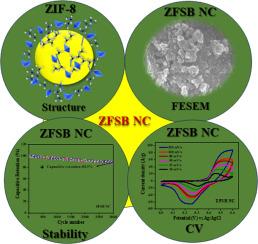Zeolitic imidazole framework-8 supported antimony trioxide nanocomposite electrode material for supercapacitor applications
IF 5.6
3区 材料科学
Q1 ELECTROCHEMISTRY
引用次数: 0
Abstract
In recent years, metal-organic frameworks (MOFs) garnered the attention of researchers in the field of energy storage, which has the specific traits of a high surface area and a stable porous structure. Here, zeolitic imidazole framework-8 (ZIF-8) were embedded with antimony trioxide (Sb2O3). The ZIF-8@Sb2O3 nanocomposite (ZFSB NC) was prepared using a solvothermal method. From the XRD study, it was observed that the prepared ZFSB NC exhibits a high degree of crystallinity along with a relatively small crystallite size. The functional groups present in the prepared materials were confirmed through FTIR analysis. The ZFSB NC exhibits a core-shell-like morphology owing to the incorporation of Sb2O3 on the surface of ZIF-8. The BET analysis demonstrated that the surface area of the NC is 362.27 m2/g. The electrochemical performance of the fabricated electrodes were investigated using a three-electrode setup with 2M KOH as an electrolyte solution. The obtained specific capacity of ZFSB NC is 480 C/g at a scan rate of 10 mV/s and 234.6 C/g at 1 A/g, which corroborates with the synergistic effect of Sb2O3 and ZIF-8, Distinctive morphology and high surface area of ZFSB NC. This elevated specific capacity of ZFSB NC occurs due to the lower RCT and RS values, which are 0.034 and 0.629 Ω. ZFSB NC has a capacitive retention of 85.3% after 3000 continuous charge/discharge cycles. The fabricated ASC device ZFSB NC//AC delivers a high specific capacity of 209.2 C/g at a scan rate of 10 mV/s. The device exhibits an elevated energy and power density of 29.28 Wh/Kg and 8000 W/Kg. Therefore, the ZFSB NC is a superior electrode material compatible with future energy storage applications.

超级电容器用沸石咪唑骨架-8负载三氧化二锑纳米复合电极材料
近年来,金属有机骨架材料以其高比表面积和稳定的多孔结构等特点受到了储能领域研究人员的广泛关注。在这里,沸石咪唑骨架-8 (ZIF-8)包埋了三氧化二锑(Sb2O3)。采用溶剂热法制备了ZIF-8@Sb2O3纳米复合材料(ZFSB NC)。XRD分析表明,制备的ZFSB NC具有较高的结晶度和较小的晶粒尺寸。通过FTIR分析确定了所制备材料中存在的官能团。由于Sb2O3在ZIF-8表面的掺入,ZFSB NC呈现出核壳状形貌。BET分析表明,NC的表面积为362.27 m2/g。在以2M KOH为电解液的三电极结构下,对制备的电极的电化学性能进行了研究。ZFSB NC在扫描速率为10 mV/s时比容量为480 C/g,在扫描速率为1 a /g时比容量为234.6 C/g,这与Sb2O3与ZIF-8的协同作用、ZFSB NC独特的形貌和高的比表面积相一致。ZFSB NC比容量的提高是由于RCT和RS值较低,分别为0.034和0.629 Ω。经过3000次连续充放电循环后,ZFSB NC的电容保持率为85.3%。制作的ASC器件ZFSB NC//AC在10 mV/s的扫描速率下提供209.2 C/g的高比容量。器件的能量和功率密度分别达到29.28 Wh/Kg和8000w /Kg。因此,ZFSB NC是一种与未来储能应用兼容的优越电极材料。
本文章由计算机程序翻译,如有差异,请以英文原文为准。
求助全文
约1分钟内获得全文
求助全文
来源期刊

Electrochimica Acta
工程技术-电化学
CiteScore
11.30
自引率
6.10%
发文量
1634
审稿时长
41 days
期刊介绍:
Electrochimica Acta is an international journal. It is intended for the publication of both original work and reviews in the field of electrochemistry. Electrochemistry should be interpreted to mean any of the research fields covered by the Divisions of the International Society of Electrochemistry listed below, as well as emerging scientific domains covered by ISE New Topics Committee.
 求助内容:
求助内容: 应助结果提醒方式:
应助结果提醒方式:


